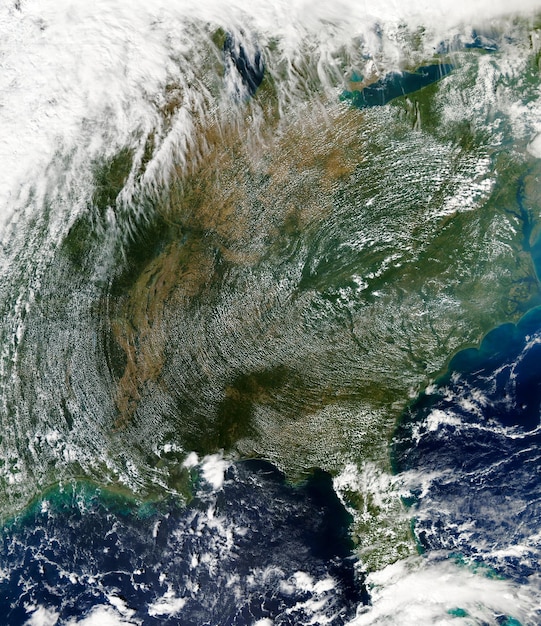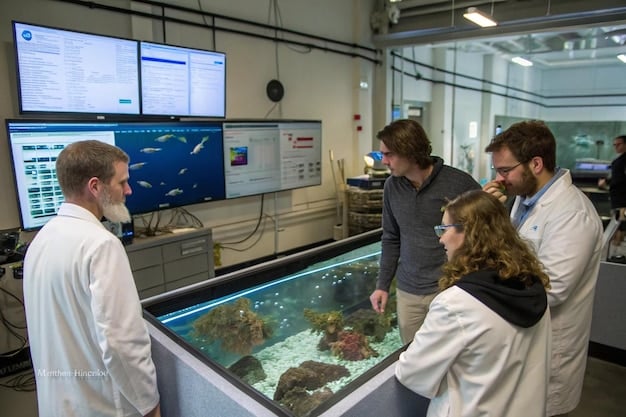US Rejoining Paris Agreement: Consequences for Climate Change

Rejoining the Paris Agreement would significantly enhance global climate action by boosting diplomatic legitimacy, financially supporting climate initiatives, and potentially accelerating domestic renewable energy transition, directly influencing the global trajectory of climate change mitigation and adaptation efforts.
Understanding what are the potential consequences of the US rejoining the Paris Agreement on climate change is crucial for anyone interested in environmental policy and international relations. This move carries profound implications, not just for the United States, but for the global effort to combat climate change, reshaping diplomatic landscapes and influencing economic transitions.
The Paris Agreement: A Framework for Global Climate Action
The Paris Agreement, adopted in 2015, stands as a landmark international treaty on climate change, bringing together nearly every nation with a common cause: to combat climate change and adapt to its effects. Its primary goal is to limit global warming to well below 2 degrees Celsius, preferably to 1.5 degrees Celsius, compared to pre-industrial levels. This ambitious target reflects the scientific consensus on the urgent need to mitigate greenhouse gas emissions to avoid the most catastrophic impacts of a warming planet. The agreement is unique in its “bottom-up” approach, where each country determines its own nationally determined contributions (NDCs), outlining its plans to reduce emissions. This flexibility aims to encourage broader participation and ownership among signatory nations.
Beyond emissions reduction, the Paris Agreement emphasizes climate adaptation and resilience. It recognizes that many countries, particularly developing nations and small island states, are highly vulnerable to the adverse effects of climate change, such as rising sea levels, extreme weather events, and food insecurity. Therefore, the agreement includes provisions for financial, technological, and capacity-building support to help these countries build resilience and cope with the inevitable impacts. The principle of common but differentiated responsibilities and respective capabilities guides these efforts, acknowledging that developed countries, historically major emitters, bear a greater responsibility to lead the way and provide support.
The innovative structure of the agreement also incorporates a robust transparency framework, requiring countries to regularly report on their emissions and progress towards their NDCs. This mechanism is designed to foster trust and accountability among parties, allowing for a collective stocktake every five years to assess global progress towards the long-term goals. This periodic review helps to inform future ambition, encouraging nations to continually strengthen their commitments over time. The agreement’s long-term vision extends beyond mitigation, aiming for a balance between anthropogenic emissions by sources and removals by sinks of greenhouse gases in the second half of this century, effectively striving for climate neutrality.
The decision of the United States, a historical major emitter and economic powerhouse, to join or withdraw from this agreement carries significant weight. Its participation impacts not only its domestic climate policy but also the global political dynamics and financial flows associated with climate action. A return to the agreement signals a renewed commitment to multilateralism and collective problem-solving on one of humanity’s most pressing challenges, potentially revitalizing international efforts and inspiring greater ambition from other nations. The agreement’s mechanisms are designed to be dynamic, allowing countries to adjust their commitments based on evolving science and global circumstances, making the US re-engagement a critical moment for its future trajectory.
The Paris Agreement’s success hinges on sustained international cooperation and unwavering commitment from all parties. Its flexible, yet accountable, framework provides a pathway for global collaboration on climate change, fostering innovation and guiding transitions towards more sustainable economies worldwide.
Enhanced Diplomatic Influence and Rebuilding Trust
The unilateral withdrawal of the US from the Paris Agreement under the previous administration significantly eroded American credibility and leadership on the global stage. Climate change, being a inherently global issue, demands collective action, and the absence of a major economic and political power created a void that other nations struggled to fill. Rejoining the agreement is a powerful symbolic gesture, signaling to allies and adversaries alike that the US is ready to re-engage with multilateral institutions and address shared global challenges. This act can immediately begin to mend strained diplomatic ties and rebuild trust, essential for effective international cooperation.
Restoration of climate leadership:
- Re-establishing a seat at the table in global climate negotiations.
- Influencing the agenda and direction of future climate policy.
- Encouraging other nations to increase their climate ambitions.
With renewed membership, the US regains its voice and influence in international climate negotiations. This allows it to shape the rules, standards, and ambition levels of future climate actions, rather than being sidelined from crucial discussions that directly impact its own economic and environmental future. It empowers the US to push for stronger commitments from other major emitters, such as China and India, leveraging its diplomatic weight and economic power. Furthermore, re-engagement offers an opportunity to forge new partnerships and strengthen existing alliances around climate initiatives, creating a more cohesive and effective international front against climate change. This diplomatic resurgence can accelerate the pace of global decarbonization and foster innovative solutions to climate challenges.
The rebuilding of trust extends beyond government-to-government relations. It also impacts the perception of American business and scientific communities internationally. When a nation demonstrates a consistent commitment to global norms and agreements, it fosters a more stable and predictable environment for trade, investment, and research collaboration. This can facilitate the exchange of green technologies and practices, benefiting both the US and its partners. The symbolism of rejoining transcends mere policy; it speaks to the values and priorities of a nation, influencing how it is perceived as a reliable and responsible global actor. It’s about signaling that the US is prepared to be a constructive partner in solving complex global problems.
Moreover, the US’s re-entry could encourage a “virtuous cycle” of increased climate ambition among other nations. When a major player like the US commits to a path of decarbonization, it sets a precedent and creates a competitive dynamic, where other countries might feel compelled to keep pace to maintain their own international standing and economic competitiveness in a rapidly evolving global economy. This renewed diplomatic weight can also be critical in advocating for equity and justice in climate action, ensuring that the burden of climate change is not disproportionately borne by the most vulnerable nations. The diplomatic dividends of re-engagement are multifaceted, fostering greater cooperation and collective ambition.
Ultimately, a restored US presence in the Paris Agreement signifies a recognition of shared responsibility and a renewed commitment to multilateralism, which is indispensable for tackling a challenge as vast and interconnected as climate change.
Accelerated Domestic Climate Action and Economic Transition
Rejoining the Paris Agreement isn’t merely an international policy shift; it has profound domestic implications for the United States. The act of re-engagement inherently signals a governmental commitment to climate action, which can catalyze significant changes within the US economy and policy landscape. By aligning with global climate goals, the US government is incentivized to implement more ambitious domestic policies to meet its NDC, pushing for cleaner energy, sustainable practices, and innovative technologies. This top-down signal can then cascade through various sectors, influencing state and local policies, corporate strategies, and consumer behavior.
The economic transition stimulated by a renewed climate commitment can be a powerful engine for growth and innovation. Increased investment in renewable energy sources like solar and wind power, coupled with advancements in energy storage and grid modernization, can create new jobs, stimulate economic activity, and reduce reliance on volatile fossil fuel markets. This shift represents not just an environmental imperative but a significant economic opportunity. Companies that embrace sustainability and invest in green technologies are likely to gain a competitive edge in a global economy increasingly prioritizing low-carbon solutions. The focus on domestic climate action can spur innovation not only in energy but also in industries such as transportation, agriculture, and manufacturing, driving efficiency and sustainability across the board.
Driving renewable energy investment
The US rejoining the Paris Agreement would likely bolster investor confidence in the renewable energy sector. Policy certainty and a clear long-term commitment to decarbonization reduce perceived risks for private capital, encouraging greater investment in large-scale renewable projects, manufacturing facilities for green technologies, and associated infrastructure. This influx of capital supports job creation across the clean energy supply chain, from engineers and construction workers to maintenance technicians.
- Increased private sector investment in solar, wind, and geothermal.
- Development of advanced battery storage and smart grid technologies.
- Creation of new green jobs and economic opportunities.
Furthermore, domestic policy changes, ranging from tax incentives for renewables to stricter emissions standards for vehicles and industries, would become more probable under a renewed commitment to the Paris Agreement. These policy levers help to accelerate the transition away from fossil fuels, fostering a competitive environment for sustainable solutions. The alignment with global climate objectives can also encourage a shift in consumer preferences, with growing demand for environmentally friendly products and services, further driving market-led decarbonization efforts.
This domestic awakening isn’t without its challenges. The transition requires significant infrastructure upgrades, retraining programs for workers in fossil fuel industries, and careful policy design to ensure an equitable transition that doesn’t leave communities behind. However, the overall impetus provided by rejoining the Paris Agreement creates a powerful impetus for change, aligning economic incentives with environmental needs. It positions the US to be a leader in the global green economy, benefiting from the rapid expansion of clean technologies and sustainable practices worldwide. The renewed commitment fosters a long-term vision for a more resilient and sustainable economy, less susceptible to the volatilities of fossil fuel prices and the escalating costs of climate-related disasters.
Ultimately, the domestic consequences of rejoining the Paris Agreement are about leveraging the full power of the US economy and innovation to build a cleaner, more sustainable future, while simultaneously meeting international climate obligations.
Global Emissions Impact and Collective Ambition
The United States is historically one of the largest emitters of greenhouse gases and, even with recent reductions, remains a significant contributor to global emissions. Its re-entry into the Paris Agreement, therefore, carries considerable weight for the collective global effort to limit warming. While the agreement itself doesn’t impose binding emission targets, the NDCs submitted by each country cumulatively determine the world’s progress. A committed US, setting ambitious targets and actively working to achieve them, significantly improves the mathematical chances of the world meeting the Paris Agreement’s temperature goals.
Beyond its direct emissions reductions, the US’s renewed participation can trigger a “leadership effect.” When a major economic power demonstrates serious commitment to climate action, it sets a powerful precedent for other nations. Developing countries, often seeking technological and financial assistance, might be more inclined to raise their own climate ambitions if they see the US leading by example and offering support. Similarly, other developed nations might feel renewed pressure to enhance their NDCs, fostering a competitive yet collaborative environment for climate action. This domino effect is crucial because no single nation, no matter how large, can solve climate change alone; it requires truly collective and increasingly ambitious action.
Impact on global ambition:
- Setting a higher benchmark: The US’s more ambitious targets can encourage other major economies to follow suit.
- Facilitating technology transfer: Increased collaboration can accelerate the spread of green technologies to developing nations.
- Strengthening the global stocktake: A united front fosters more robust assessments of collective progress.
The global stocktake mechanism of the Paris Agreement, which assesses collective progress every five years, becomes far more meaningful with full US participation. A committed US actively tracking and reporting its emissions and progress strengthens the transparency framework and provides a more accurate picture of global efforts. This transparency is vital for identifying gaps in ambition and determining where further action is needed. Without the US, a significant piece of the global puzzle is missing, making comprehensive assessments challenging. Its return enables a more holistic and accurate global climate accounting, which is critical for steering future collective policy decisions.
Moreover, the US can play a vital role in mobilizing international climate finance, particularly for adaptation and mitigation efforts in vulnerable developing countries. Its influence within international financial institutions and its capacity to provide bilateral aid can significantly increase the resources available for climate action globally. This financial support is not just about burden-sharing; it’s about enabling a global transition that is equitable and inclusive, ensuring that nations most vulnerable to climate impacts are not left behind. By contributing to global financial mechanisms, the US helps to build trust and shared responsibility, essential for sustained global climate cooperation.
In essence, the US rejoining the Paris Agreement elevates the level of collective ambition worldwide. It transforms the global climate conversation from one of contention and retreat to one of renewed commitment and shared purpose, directly impacting the trajectory of global emissions and the world’s chances of avoiding the most severe effects of climate change.

Shifting Geopolitical Dynamics and International Cooperation
Climate change is not just an environmental issue; it is a profound geopolitical challenge that shapes alliances, economic competitiveness, and security considerations worldwide. The US withdrawal from the Paris Agreement created a vacuum in global climate leadership, which allowed other nations, notably China and the European Union, to step in and assert their influence. The US rejoining the agreement fundamentally shifts these dynamics, re-inserting American influence into a critical area of international policy and potentially recalibrating global power balances.
The EU, as a consistent advocate for climate action, has positioned itself as a leading force in green diplomacy. A re-engaged US can either complement or complicate this role. Ideally, it would lead to a stronger transatlantic alliance on climate issues, providing a formidable partnership to pressure less ambitious nations. However, it also requires careful coordination to avoid duplication or conflicting strategies. China, while a major emitter, has also made significant investments in renewable energy and has expressed its own climate ambitions. The US re-entry introduces a new dynamic into US-China relations, potentially opening avenues for cooperation on climate while also maintaining a competitive edge in green technology. This complex interplay will define the future of global climate governance.
Potential shifts in global cooperation:
- Stronger EU-US cooperation on climate and green technologies.
- Increased pressure on major developing economies to accelerate their transitions.
- New opportunities for climate finance and technology transfer mechanisms.
International cooperation also extends to areas beyond emissions reduction. Climate change is increasingly recognized as a threat multiplier, exacerbating existing vulnerabilities and contributing to migration, resource scarcity, and instability. By re-engaging, the US can contribute to global discussions on climate security, working with international partners to address the humanitarian and geopolitical consequences of a changing climate. This includes supporting climate-resilient development in vulnerable regions, building early warning systems for extreme weather, and fostering regional stability to prevent climate-induced conflicts. Such efforts require broad international collaboration, and US leadership is crucial in mobilizing resources and expertise.
Furthermore, the US rejoining fosters an environment more conducive to developing global standards for carbon pricing, green finance, and sustainable supply chains. As more countries commit to net-zero targets, the need for harmonized international policies becomes greater to ensure fair competition and prevent carbon leakage. The US can leverage its position to advocate for robust standards that promote a level playing field and accelerate the global transition to a low-carbon economy. This includes engaging with the G7, G20, and various UN bodies to integrate climate considerations into broader economic and trade discussions, ensuring that climate action is not an isolated policy but a fundamental component of international economic strategy.
In essence, the return of the US to the Paris Agreement reshapes the geopolitical chessboard, paving the way for more coordinated, ambitious, and effective international responses to climate change, while also influencing the rise of new economic and diplomatic relationships centered around sustainability.
Technology Transfer and Climate Finance Acceleration
One of the critical enabling factors for global climate action, particularly in developing nations, is access to adequate climate finance and advanced green technologies. Many countries lack the financial resources or technological capabilities to rapidly transition away from fossil fuels or effectively adapt to the impacts of climate change. The US rejoining the Paris Agreement has the potential to significantly accelerate the flow of both capital and technology, thereby leveling the playing field and fostering more equitable climate action worldwide.
The US, as the world’s largest economy and a major hub for technological innovation, possesses unique capabilities in developing and deploying cutting-edge clean energy solutions, carbon capture technologies, and climate-resilient infrastructure. Its re-engagement in the Paris Agreement signals a willingness to not only invest domestically but also to facilitate the transfer of these technologies to other nations. This can occur through various mechanisms: direct foreign aid, public-private partnerships, multilateral development banks, and intellectual property licensing agreements. Such transfers are vital for building capacity in developing economies, allowing them to leapfrog older, carbon-intensive development pathways and embrace sustainable growth.
Bolstering climate finance mechanisms
The Paris Agreement includes a commitment from developed countries to mobilize and provide financial resources to assist developing countries with both mitigation and adaptation. While the US technically continued to contribute to some climate finance initiatives even after withdrawal, its formal re-entry into the agreement reinforces its commitment to these goals. This could lead to a renewed pledge to the Green Climate Fund (GCF), a key financial mechanism of the agreement, and overall increased contributions to various climate-related funds. This influx of capital is critical for projects such as:
- Developing renewable energy infrastructure in emerging markets.
- Implementing climate adaptation measures like early warning systems and resilient agriculture.
- Supporting capacity building for emissions accounting and climate policy development.
- Facilitating the transition from fossil fuels to cleaner energy sources.
Beyond direct contributions, the US can play a pivotal role in de-risking private sector investments in green projects in developing countries. Through guarantees, blended finance structures, and technical assistance, it can encourage private capital to flow into critical climate initiatives that might otherwise be deemed too risky. This leverages significant private sector resources, far beyond what governments alone can provide. The US’s influence in international financial institutions like the World Bank and the International Monetary Fund also means it can advocate for the mainstreaming of climate considerations into their lending practices, ensuring that development finance aligns with climate goals.
Moreover, active participation in the Paris Agreement’s technology framework enables the US to share best practices, research findings, and technical expertise more effectively with other nations. This collaborative approach fosters a global ecosystem of innovation where solutions developed in one country can be adapted and scaled in others, creating a cumulative positive impact on global emissions and resilience. This aspect of the agreement is often overlooked but is fundamental to achieving ambitious climate targets worldwide. It represents a shift from unilateral action to a shared global effort to innovate and implement sustainable solutions.
In short, the US rejoining the Paris Agreement acts as a catalyst for significantly increasing the flow of essential climate finance and the diffusion of critical green technologies, which are indispensable for achieving the ambitious goals of the agreement on a global scale.

Building Climate Resilience and Adaptation Efforts
While mitigation—reducing greenhouse gas emissions—is paramount, the reality is that the planet is already experiencing the impacts of climate change, and these impacts are projected to intensify. Therefore, building climate resilience and implementing effective adaptation strategies are equally critical aspects of global climate action. The US rejoining the Paris Agreement strengthens these efforts both domestically and internationally, fostering a more prepared and robust global community in the face of environmental shifts.
Domestically, renewed commitment to the Paris Agreement can spur increased investment in climate resilience infrastructure and planning across the US. This includes upgrading coastal defenses against rising sea levels, reinforcing power grids to withstand extreme weather, developing drought-resistant agricultural practices, and managing forests to prevent wildfires. By recognizing the global framework, the US may be more inclined to adopt a comprehensive, long-term national adaptation strategy that integrates climate risks into all aspects of planning and development. This goes beyond reactive measures, aiming for proactive resilience building that minimizes future damages and protects communities and ecosystems.
Key areas of climate resilience:
- Coastal community protection and infrastructure hardening.
- Development of heat-resilient urban planning and cooling centers.
- Adaptive agriculture and water resource management strategies.
- Improved early warning systems for extreme weather events.
Internationally, the US’s re-engagement allows it to contribute more effectively to global adaptation efforts, particularly in vulnerable developing countries. These nations, often with limited resources, bear a disproportionate share of climate change impacts despite having contributed least to the problem. The US can provide technical assistance, financial aid, and expertise in areas such as climate risk assessment, disaster preparedness, and sustainable land management. Its participation within the Paris Agreement’s adaptation framework facilitates knowledge sharing and the scaling up of successful adaptation practices across diverse geographies.
Furthermore, the US can champion the cause of “loss and damage” within international climate negotiations. This concept addresses the unavoidable impacts of climate change that go beyond what societies can adapt to, requiring financial and technical support for recovery and rehabilitation. While historically a contentious issue, the US’s re-engagement could foster a more constructive dialogue on how to address these severe consequences, contributing to a more just and equitable global response to climate change. This involves partnerships with international organizations and civil society to deliver aid effectively and compassionately to affected communities.
The shared learning fostered by the Paris Agreement’s adaptation efforts benefits all nations. While specific climate impacts vary by region, the principles of resilience building and effective adaptation can be universally applied and refined through international collaboration. The US can both import and export best practices, learning from other countries’ experiences in managing similar climate risks and sharing its own innovations. This reciprocal relationship strengthens global capacity to anticipate, absorb, and recover from climate shocks, making communities everywhere more secure. By actively participating in this aspect of the agreement, the US solidifies its commitment to protecting not only its own citizens but also the most vulnerable populations worldwide from the unfolding realities of a changing climate.
In essence, rejoining the Paris Agreement amplifies the US’s commitment to proactive climate resilience and robust adaptation strategies, both at home and across the globe, strengthening humanity’s collective ability to live with and minimize the impacts of a warming world.
| Key Area | Brief Impact Description |
|---|---|
| 🤝 Diplomatic Influence | Rebuilds trust, restores US leadership in climate negotiations, and encourages global ambition. |
| ⚡ Domestic Progress | Accelerates clean energy investments, job creation, and policy shifts towards decarbonization within the US. |
| 🌍 Global Emissions | Significantly boosts the collective global effort to meet temperature goals and inspires stronger NDCs. |
| 💰 Climate Finance | Increases financial and technological support for developing nations’ mitigation and adaptation efforts. |
Frequently Asked Questions About the US Rejoining the Paris Agreement
The Paris Agreement is a global accord within the United Nations Framework Convention on Climate Change (UNFCCC), dealing with greenhouse gas emissions mitigation, adaptation, and finance. It is crucial because it unites nearly all nations in a common objective to limit global warming, providing a framework for collective climate action and accountability across the globe.
Rejoining signals a renewed governmental commitment to climate action, likely prompting more ambitious domestic policies. This includes increased investment in renewable energy, tighter emissions standards, and incentives for green technologies. It aligns national efforts with international goals, potentially accelerating economic transition towards a low-carbon future and creating new job opportunities in green sectors.
US re-engagement can significantly boost global climate finance by renewing pledges to funds like the Green Climate Fund and encouraging private sector investment in developing countries. Its influence helps de-risk projects and mainstream climate considerations into international financial institutions, ensuring more resources flow to vulnerable nations for mitigation and adaptation efforts.
Yes, absolutely. By re-engaging, the US can rebuild trust and reassert its diplomatic influence in global climate negotiations. It allows the US to actively shape future climate policy, encourage higher ambition from other nations, and foster new international partnerships, effectively restoring its position as a key leader in the global fight against climate change.
Rejoining strengthens both domestic and international resilience. Domestically, it can spur investment in climate-resilient infrastructure. Globally, the US can provide vital technical and financial assistance to vulnerable nations, share best practices, and contribute to addressing “loss and damage,” fostering a more prepared and adaptable global community against climate impacts.
Conclusion
The decision of the United States to rejoin the Paris Agreement on climate change is not a mere procedural formality; it is a profound re-alignment with global climate action, carrying multifaceted consequences that reverberate across diplomatic, economic, and environmental spheres. This move decisively restores American credibility and leadership on the world stage, fostering renewed trust and invigorating multilateral efforts to combat the climate crisis. Domestically, it provides a powerful impetus for accelerating the transition to a clean energy economy, spurring innovation, job creation, and sustainable development. Globally, it significantly enhances the collective ambition to reduce emissions and mobilizes critical climate finance and technology transfer to developing nations. While challenges remain, the US’s re-engagement offers a clear pathway toward a more cooperative, resilient, and sustainable future, underscoring the indispensable role of collective action in addressing humanity’s most pressing environmental challenge.





